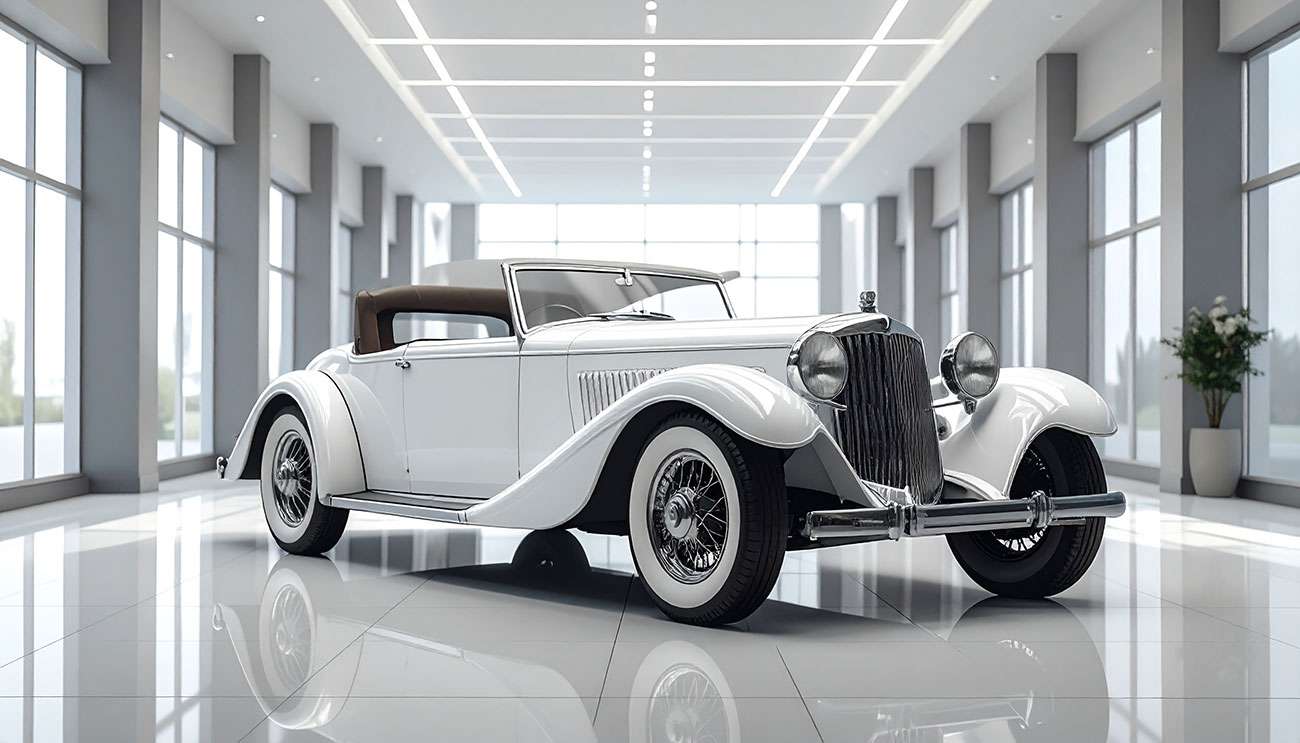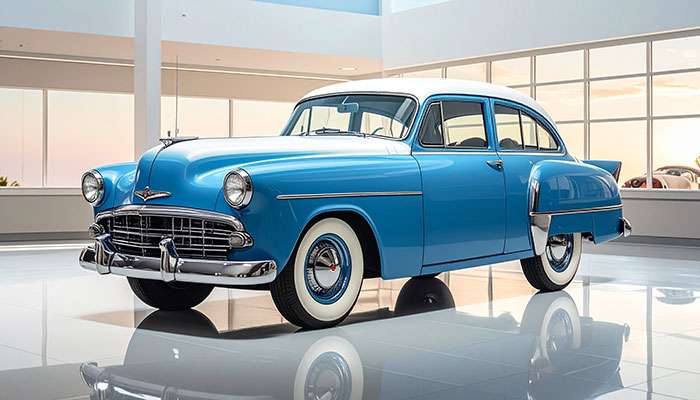
Whitewall tires are automotive tires that feature white rubber stripes or complete white sidewalls that create a striking contrast against the black tread surface. What many people don't realize is that whitewall tires started as a practical manufacturing decision rather than a style choice.
The story begins with the natural rubber formula used in early tire production, which gave tires an off-white appearance. Manufacturers later added zinc oxide to brighten this white color, though these early tires quickly turned beige when driven on dirt roads.
Around 1910, B.F. Goodrich made a breakthrough by adding carbon black to tire compounds, dramatically improving their strength and durability. Here's where it gets interesting: some manufacturers only added this carbon black to the tread surface to save money, accidentally creating the first whitewall tire. What started as cost-cutting became the foundation for one of automotive history's most recognizable style features.
The shift from practical to prestigious happened during the 1930s. Ford changed everything on April 6, 1934, when they introduced whitewalls as an $11.25 option (that's $264 in today's money) on all their new vehicles. This premium pricing made whitewalls a clear luxury upgrade that separated style-conscious owners from those who stuck with standard blackwall tires.
The white stripe width tells its own story through automotive history. Wide whitewalls dominated luxury vehicles during the early 1950s. By 1962, the industry made a major shift to one-inch whitewalls, which kept getting narrower throughout that decade. Manufacturers got creative during the 1960s and 1970s, with Cadillacs and other luxury sedans featuring distinctive double and triple whitewall designs.
Even though mainstream production ended by the mid-1980s, whitewall tires remain essential for classic car culture today. They're crucial for authentic restorations, custom builds, and hot rods that need period-correct styling. Coker Tire made a game-changing move in 1994 by introducing the first wide whitewall radial tire, giving enthusiasts vintage looks with modern performance. This innovation lets classic car owners get that nostalgic whitewall appearance without giving up contemporary handling and safety.

When it comes to automotive styling, few features made as dramatic an impact as whitewall tires. The journey from manufacturing accident to coveted luxury feature spans several decades and reflects changing American tastes in automotive design.
The relationship between whitewall tires versus blackwall tires was completely different in the early days. Black tires actually cost more to produce and were considered the premium choice through the 1920s. The extra carbon black made them stronger and easier to maintain, which appealed to luxury car buyers.
This perception changed dramatically by the late 1920s. The striking contrast between white sidewalls and black treads caught the attention of upscale customers. Luxury manufacturers like Duesenberg and LaSalle quickly recognized this appeal and began featuring whitewalls prominently in their marketing. These high-end vehicles were typically driven by chauffeurs, who were responsible for keeping the white sidewalls spotless - a time-consuming task that actually added to their exclusive appeal.
Ford Motor Company changed everything on April 6, 1934, when they introduced whitewall tires as an $11.25 option across their entire lineup. At roughly $264 in today's money, this pricing made whitewalls accessible to middle-class buyers for the first time.
The impact was immediate and substantial. Whitewall popularity grew throughout the decade as ordinary drivers could now afford what had been an elite styling feature. This accessibility shifted how Americans viewed automotive accessories, turning whitewalls from exclusive luxury items into attainable upgrades.
World War II put whitewall production on hold as rubber became a strategic military resource. After the war, manufacturers initially returned to featuring blackwall tires in their advertisements. However, this changed rapidly as prosperity returned.
Studebaker led the charge in 1948, featuring whitewalls on most of their new models. By 1949, virtually every American automaker showed nearly all their vehicles with whitewall tires in advertising materials. This explosion coincided with the post-war economic boom and Americans' desire for style and luxury after years of wartime austerity. Whitewalls became as essential to 1950s automotive style as chrome trim, defining an entire era of American car design.
Whitewall tires fell out of mainstream production due to practical limitations that became impossible to ignore as automotive technology advanced.
Pure white rubber compounds simply couldn't match the durability of black tire formulations. Whitewalls scuffed against curbs, turned yellow from road grime, and demanded constant attention to maintain their appearance. Owners discovered they needed specialized whitewall cleaners, as standard household products or alcohol-based solutions could permanently damage the white sidewalls. Some drivers even installed "curb feelers" - wire extensions that scraped against curbs before the tire could make contact. Manufacturers struggled with quality control issues, occasionally rejecting entire shipments when the white sections showed color inconsistencies or blemishes.
The 1970s brought radial tire technology that made bias-ply whitewalls obsolete. Radial construction features cords that run straight across from bead to bead, with steel belting beneath the tread area. This design delivers superior performance, handling, and tread life compared to the bias-ply construction used in traditional whitewalls. Radials also provide better wet-weather traction through improved water evacuation channels. The manufacturing processes for radial tires work best with all-black compounds that incorporate carbon black throughout the tire structure.
Modern automotive design favored lower-profile tires that couldn't accommodate wide white stripes. Whitewall stripe widths had already started shrinking during the 1950s as design trends evolved. Most vehicles switched to narrow one-inch whitewalls by 1962. Lower-profile designs offered improved handling, better steering response, and more space for larger brake systems. Contemporary styling eventually embraced minimalist aesthetics with larger wheels and very low-profile tires, leaving no room for the wide white stripes that defined classic whitewalls.
Whitewall tires maintain their importance in specialized automotive markets, serving enthusiasts who demand authentic period styling and vintage aesthetics.
Authentic restorations require period-correct whitewall tires that match original vehicle specifications exactly. We work with companies like Coker Tire, who specialize in manufacturing collector vehicle tires using original molds to ensure historical accuracy. Coker Tire's award-winning Bias Look Radial introduced in the 1970s delivers the nostalgic whitewall appearance while providing modern tire performance and handling characteristics.
Pricing typically ranges around $150 per tire, though entry-level options start from $60 depending on size and construction. When selecting whitewalls for your restoration, consider these historical guidelines: vehicles built before 1954 typically featured three-inch or wider whitewalls, while post-1964 models used one-inch or narrower white stripes. This attention to period-correct details ensures your restoration maintains authentic visual appeal.
Whitewalls remain essential for hot rods, lowriders, and custom automotive builds. Firestone whitewalls with authentic tread patterns dominate the traditional hot rod scene, particularly popular in sizes like 560-15 with various whitewall widths available. The width you choose creates different era aesthetics—wide 3¼-inch whitewalls evoke the classic 1930s-1940s look, while narrower 1-inch varieties suggest early 1960s styling.
Modern custom builders also embrace contemporary interpretations, including raised white lettering and gold-striped sidewalls that appeal to today's custom car enthusiasts. These options allow you to achieve the vintage whitewall appeal while expressing your personal style preferences.
The motorcycle market embraces whitewall tires as "an instant style time-machine" for custom builds. Specialty manufacturers like Beck produce 16-inch and 18-inch whitewall motorcycle tires designed specifically for custom applications. These tires add vintage elegance while completing the aesthetic vision for classic-inspired motorcycle builds.
Additionally, the whitewall maintenance market supports these specialty tires with dedicated cleaning products that address their unique care requirements. While whitewalls demand more maintenance than standard black tires, the distinctive styling they provide makes the extra effort worthwhile for enthusiasts seeking authentic vintage appeal.
White wall tires evolved from a manufacturing accident to an iconic automotive status symbol, representing luxury and style throughout the mid-20th century before declining due to practical limitations.
• Whitewalls originated accidentally - Early tires were naturally white until carbon black was added for durability, creating the first contrasting sidewalls by cost-saving manufacturers.
• Ford democratized luxury in 1934 - By offering whitewalls as an $11.25 option, Ford made this premium feature accessible to middle-class buyers for the first time.
• Maintenance killed mainstream appeal - White rubber scuffed easily, yellowed over time, and required specialized cleaners, making them impractical for everyday drivers.
• Radial tire technology ended the era - The shift to superior radial construction in the 1970s favored all-black designs and lower-profile tires incompatible with wide white stripes.
• Classic car culture keeps them alive - Today's $60-150 whitewall tires serve restoration enthusiasts, hot rod builders, and custom motorcycle creators seeking authentic vintage esthetics.
The whitewall's journey from functional necessity to fashion statement to niche specialty perfectly mirrors how automotive trends evolve with technology and consumer preferences.
Whitewall tires originated as a byproduct of manufacturing processes. Early tires were naturally white, and when carbon black was added to improve durability, some manufacturers only added it to the tread surface for cost efficiency, inadvertently creating the first whitewall tire.
Whitewall tires transitioned from a manufacturing quirk to a luxury status symbol in the 1930s. Ford's introduction of whitewalls as an affordable option in 1934 made them accessible to middle-class consumers, boosting their popularity and association with prestige.
Manufacturers phased out whitewall tires due to durability issues, high maintenance requirements, and the shift to radial tire technology in the 1970s. Additionally, changing automotive design trends favored lower-profile tires that couldn't accommodate wide white stripes.
Yes, whitewall tires are still available, primarily for classic car restorations, custom builds, and hot rods. Specialized manufacturers like Coker Tire produce whitewalls that combine vintage esthetics with modern performance features.
Modern whitewall tires for classic cars and custom builds generally range from about $60 to $150 per tire. Pricing can vary based on size, brand, and specific design features, with some specialty or high-end options potentially costing more.